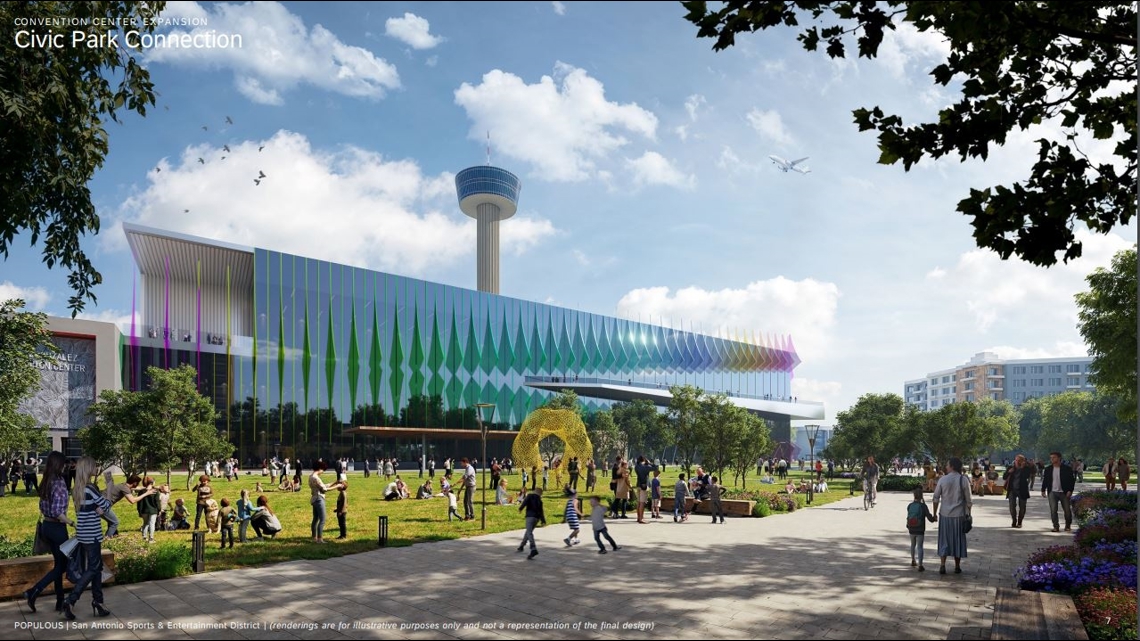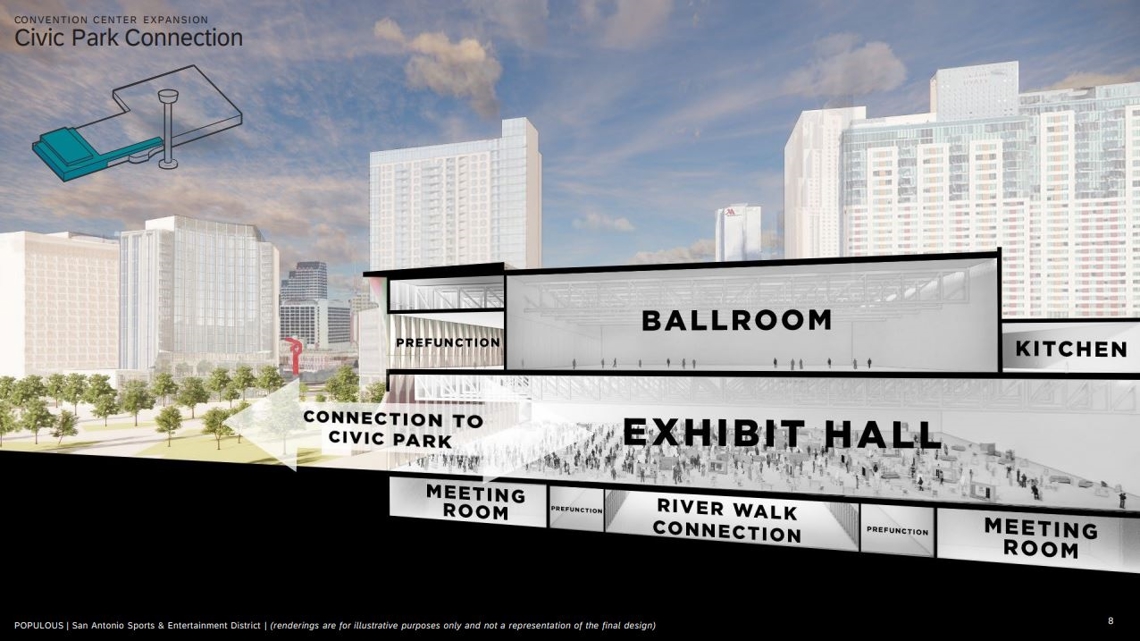It’s a priority component of the city’s overarching Project Marvel dream.
SAN ANTONIO — As major cities across Texas make plans to expand their biggest event spaces, San Antonio hopes to do the same with the Henry B. González Convention Center.
In their first follow-up meeting since being publicly briefed on Project Marvel, the city’s ambitious plan to convert part of downtown San Antonio into a sports and entertainment hub, the Missouri-based architecture firm Populous and Massachusetts-based project management company CSL Consulting presented City Council with the initial findings of a feasibility study for the convention center.
Populous was the firm the city hired for the previous convention center expansion as well.
‘We want to expand the building by up to 200,000 square feet of exhibition space. That’s challenging, given the site,” said Michael Lockwood, an architect with Populous.
Populous’ recommended renovation plan focuses on the west side of the building, where there are older meetings rooms and a bridge hall limited in how much weight it can support, thus preventing it from being a top-tier exhibition space.
“And then the west wing building was never remodeled back into meeting space; it’s basically been mothballed in place,” he said. “So it’s a great opportunity to reinvigorate that portion of the site.”
In the proposed expansion’s design concepts, the center’s exhibit hall would spill onto Hemisfair/Civic Park. On top of it would be the new ballroom, with glass overlooking the park. In the River Walk connection area the river would be brought up to a certain point, and a proposed pedestrian connection would run under the building and into the park, with meeting rooms on both sides.


Lockwood also pointed to how the design incorporates outdoor space by spilling into Civic Park, where events held at the convention center can continue. The proposed ballroom built on top of the exhibit hall would be 70,00 0to 75,000 square feet in size and feature moveable walls into the smaller “prefunction” space.
The design would maximize convention center usage by allowing staff to “stack” consecutive events or even overlap them to “keep everything as active as possible” and have “as few down days, or dark days, as possible.”


The economic impact
As for why the city is hearing plans for the Henry B. González Convention Center first, it comes down to basic urgency.
John Kaatz, of CSL, said the exhibit halls historically run at about 70% occupancy, though it hasn’t reached that number since 2018. And convention market strength, he said, often parallels overall economic success.
“What this suggests to us is we’re turning away some really good business,” he said. “We’re not able to accommodate the convention market in a way that we’d like.”
Without any renovation to maintain or expand the convention center, Kaatz said, the city will eventually be losing revenue—especially with other major cities in the state planning their own billion-dollar renovations. San Antonio, the seventh largest city in the U.S., currently has about 513,900 square feet of exhibit space.
Populous’ plan would shoot it up to 10th, though still behind Dallas and Houston. It would also, however, jolt San Antonio from 16th to eighth when it comes to U.S. cities with the largest contiguous exhibition spaces.
Overall, if the recommended redesign and additions happen, Kaatz said it would equip the downtown convention center to accommodate 92% of the conventions and trade shows interested in coming to San Antonio. That would mean getting annual direct spending from convention attendees on things like hotels, food and retail back to the $189.8 million mark the Alamo City saw in 2018, a high-water mark for the past 14 years.
“If we do nothing… we’re looking at a 10% decrease (in average annual revenue),” explained John Kaatz, with CSL. “By the time Dallas opens up, Houston’s open, Austin’s open, we are going to go down if we do nothing. I’s at least 10% and it’s probably going to continue to trickle down after that. So, the delta is really 30 percentage points of impact (if we) do nothing versus the investment.”
The city is already losing money as a result of the lack of space. Over the past six years, the city has lost out on $700 million dollars in revenue because the convention center wasn’t big enough and organizations have chosen to take their events elsewhere.
But how much will it cost? An estimate has yet to be determined. City Manager Erik Walsh explained that, some time next year, city staff will be presenting the entire feasibility study for all aspects of Project Marvel – including renovations to the Alamodome, the conversion of a courthouse into a live event space and a land bridge over Interstate 10 – to include an approximate price tag.
The ultimate size of a renovated González Convention Center is yet to be determined.
“We’ll talk about ranges at some point, but we’re going to follow the same track we did with the airport (expansion),” Walsh said. “Similar to the airport development where we had a range, an up-to (mark). And it wasn’t until we went to contract for construction.”
While how much money the expansion will cost is yet to be determined, there are options for how the city may pay for it, including already existing tax revenue from the Hotel Occupancy Tax.
